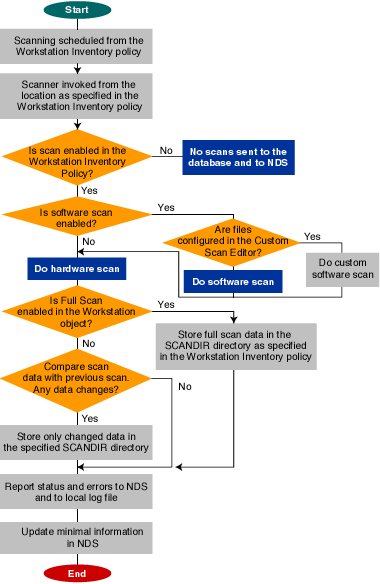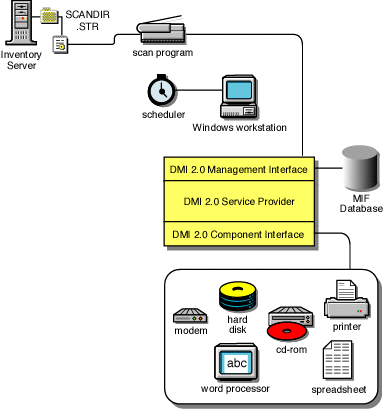ZfD uses the following platform-dependent scanners to collect workstation hardware and software information:
The scanners collect hardware details such as: floppy disk drive, hard disk drive, BIOS, bus, mouse, keyboard, display adapters, network adapter cards, modems, Jaz* drives, Zip* drives, sound cards, memory cards, serial ports, and parallel ports. The software scanning includes checking for applications on the workstations and reporting the information about the scanned software, such as the vendor name, and the product name and version.
The scan information collected by the scanners is stored as scan data files (.STR) in the scan directories (SCANDIR). A minimal set of scan data is also stored in the eDirectory Workstation object.
The following sections contain detailed information about the Inventory scanners:
Also, see Customizing the Software Scanning Information of Vendors and Products .
The scanning process is as follows:
Software Scanning Option: By default, the Scanner collects the hardware information of the workstations. If the Enable Software Scan option is enabled in the Workstation Inventory policy, the Scanner collects information about software applications.
Custom Scan Editor: If the Software Scanning option is enabled, the Scanner reports the software information of all .EXE files on the scanned workstations. You configure the applications that you want the Scanner to collect information by using the Custom Scan Editor. For more information, see Customizing the Software Scanning Information of Vendors and Products .
Full Scan: When scanning the workstation for the first time, the Scanner collects the complete inventory of the workstation, referred to as a full scan. After the workstation is scanned, the next time the Scanner compares the current inventory data to the history data that it maintains. If there are any changes to the workstation, the Scanner reports the delta scan data, which contains only the changes in inventory since the last scan was reported. The Delta Scan setting is the default scan operation for each successive scan after the first scanning of the workstation.
Enable Scan of Workstation: The Scanner collects the inventory information of the workstations associated with the Inventory Service object when this option is enabled.
Location of the SCANDIR Path: The Scanner stores the scan information of the workstations in the scan data files (.STR) located in the scan directory (SCANDIR) on the inventory server.
Start Full Scan: The Scanner enforces a complete scanning of the workstation and this setting overrides the option set in the Inventory Service Object property page associated with the workstation.
For more information, see Setting Up Workstation Inventory .
If the workstation is instrumented for DMI, the scanners query the DMI Service Layer. For more information, see DMI-Compliant Scanners . If the workstations are WMI compliant, the scanners also collect the hardware data by querying the WMI information. The scanners also probe the workstations for hardware data.
We recommend that you instrument DMI/WMI on your workstations and install DMI/WMI components that are supplied by the vendors.
The Scanner tracks the changes in scan data by storing the scan data in the HIST.INI history file. For subsequent scans, the Scanner compares the history scan data with the actual collected data and generates the .STR file.
The Scanner updates the eDirectory object with the scan data contained in MINFO.INI.
The following flowchart illustrates the hardware and software scanning process:

A summary of the files that the Scanner processes follows:
The scanners follow this process for software scanning:
By default, the software scanning includes collecting information of files with .EXE file extensions. See Customizing the Software Scanning Information of Vendors and Products for information on the list of software applications you can scan for.
If the software applications on the workstation are installed using Microsoft* Installer, the scanners use the information from Microsoft Installer (MSI). Otherwise, the scanners collect the software information from the header of the software application files.
After the scan data is stored in the database, you can view, query, or generate reports of the software information.
The scanners for scanning workstations (Windows 95/98 and Windows NT/2000) also include scanning based on the industry-standard Desktop Management Interface (DMI) specification 2.0. These programs use the Management Interface (MI) of DMI to look for the hardware components installed on the workstation. The scanners will scan for specific components that are instrumented on the workstation through DMI. The scanners will query the DMI service layer to retrieve this information.
The MI allows the DMI-compliant scanners to probe the Service Provider within the Service Layer. The Service Provider collects information from the manageable components and stores the collected information in the Management Information Format database. The Component Interface (CI) communicates with the manageable components and the Service layer. The following figure shows the scanner interaction with DMI.

For more information on DMI standards, see the DMTF Web site.
To scan the DMI data of the managed workstations, you need to instrument the workstation by installing the vendor-specific components. To install the DMI 2.0 Service Layer on the workstations, use the DMISLSnappshot.AOT file located in the \PUBLIC\ZENWORKS\DMISNAPSHOT directory to create a NAL Application Object.
HINT: If the workstations are DMI compliant, the scanners will collect hardware data by querying the DMI Service Layer. Otherwise, the scanners probe the workstations.
We recommend that you instrument DMI and also install DMI components that are supplied by the vendors.
For example, if you have a Compaq* Family Deskpro EN Model-SFF6500 workstation running under Windows 98, download the Management Product software - Compaq Insight Management Desktop Agents software for Windows 95/98/NT from the Compaq Web site.
For Dell* workstations, access the DM/Desktop Management Utilities software from the Dell Web site.
The scanners collect hardware data from Windows 95/98/NT/2000 workstations based on Microsoft's Windows Management Instrumentation (WMI) specification.
WMI is the Microsoft implementation of Web-Based Enterprise Management (WBEM) that enables accessing management information in an enterprise environment. WMI 1.5 is fully compliant with Common Information Model (CIM) schema, which is an industry standard. For more information, see Microsoft WMI Web site. WMI also works with existing management standards, such as DMI and SNMP.
The scanners use WMI to look for the hardware components installed on the workstation. The scanners also scan for specific components that are instrumented on the workstation through WMI.
WMI-compliant scanners are supported on Windows 98, Windows 95, and WIndows NT/2000 managed workstations only.
You can view the WMI data of the managed workstations in the Workstation Inventory Summary.
To obtain WMI information from the workstation:
Download Microsoft's Windows Management Instrumentation - Core Software Installation from Microsoft WMI Web site.
To instrument a workstation for WMI, you need to download only the WMI Core Software Installation.
IMPORTANT: On Windows 2000 workstations, WMI Core Software is already installed.
To troubleshoot any WMI-related problems, you can avail WMI SDK download.
Install WMI Core Software on Windows NT/95/98 workstations.
On the server, modify the \PUBLIC\ZENWORKS\SCANSOURCE.INI file. Update the following entry in this file:
[SOURCE]
do WMIScan= scansetting
where scansetting is set to either TRUE or FALSE.
By default, scansetting is set to TRUE and WMI scanning is enabled. To disable WMI scanning, set this to FALSE.
The scansetting modifications effect only those workstations that are connected to the server. For example, if you set the scansetting to False on a server, such as AUS-INV-SERVER, only those workstations that are connected to this server will not be scanned for WMI.
The scanners collect the following hardware information.
The following table contains the DMI/WMI components that are addressed in the DMI/WMI information.
NOTE: PCMCIA modems are connected to the computer through the PCMCIA slots on the workstations. The Scanner detects PCMCIA modems that are active on the computer. If you want to know which modem is installed on the computer, use the Windows System Device Manager on the Windows workstation.
Non-PCMCIA modems are connected to the computer through the external ports. For example, some non-PCMCIA modems are connected through the serial ports. The Scanner detects non-PCMCIA modems that are installed on the computer.
Non-PCMCIA modems may not be active at the time of scanning. Also, these modems may not be connected, though configured on the computer. In this case, the Scanner detects the modem and reports the scan information of the modem.